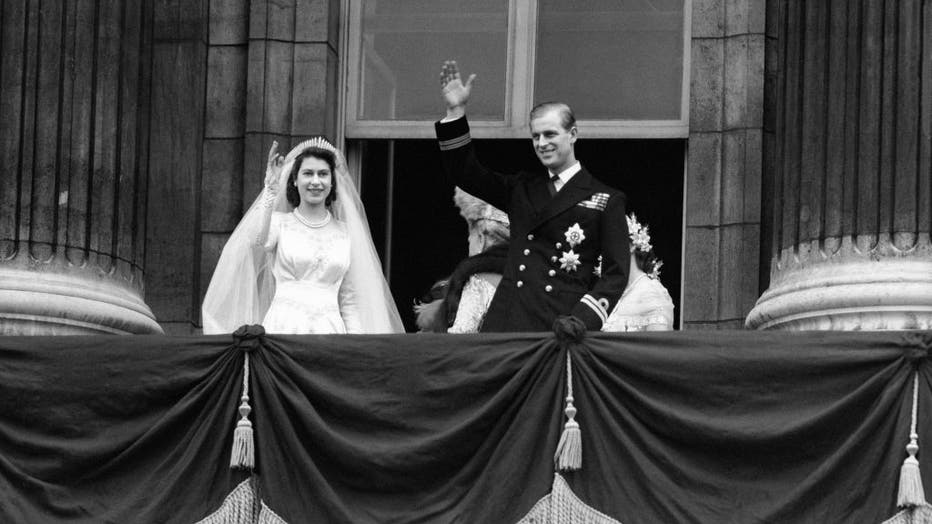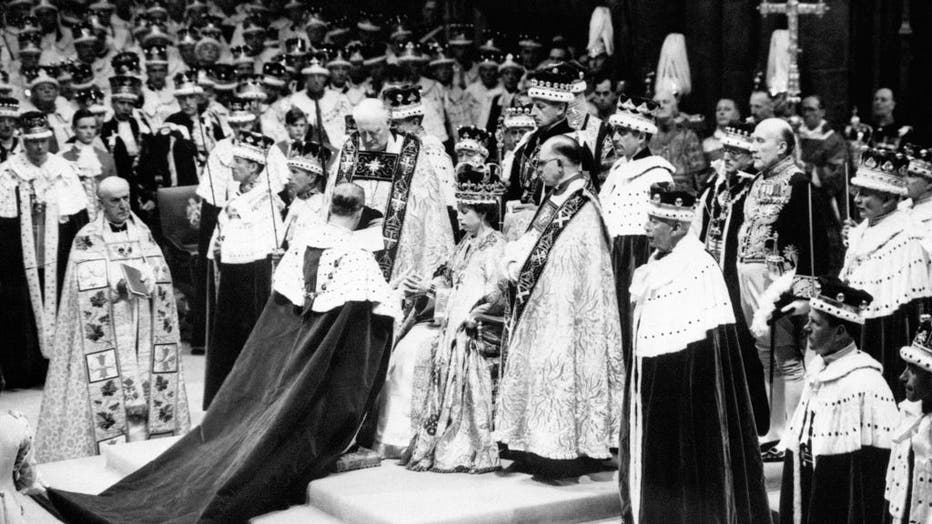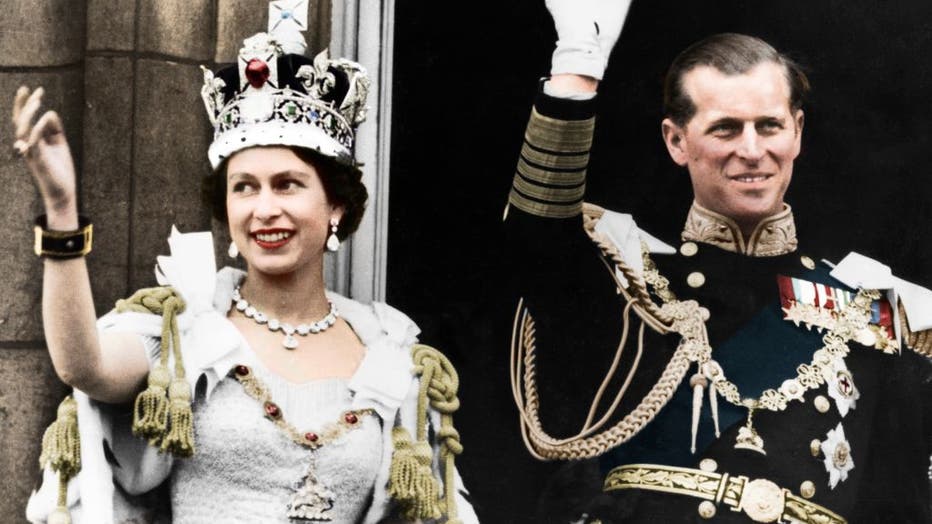Prince Philip and Queen Elizabeth II: A love story
LONDON - Queen Elizabeth II has worn the British crown for 69 years, but she wore her wedding ring even longer.
She was married to her beloved husband, Prince Philip, for 74 years, until his death on April 9 marked the end of one of the longest royal romances in the world.
And for the first time, she must sit the throne without the love of her life by her side.
RELATED: Royal consorts, past and future, in Britain's changing monarchy
The "Prince Charming" trope is common in fairytales, but it was real life for her majesty. It wasn’t quite love at first sight — the two met when they were young children. But scholars note a 13-year-old Princess Elizabeth became quite smitten with Philip, who was then the dashing young prince of Greece and Denmark, while touring the Britannia Royal Naval College.
According to "The Little Princesses," a memoir written by Elizabeth’s governess Marion Crawford, Philip caused the young princess to blush quite a bit.
But she got the chance to see him blush during a 1943 Christmas play at Windsor Castle. Elizabeth knew Philip would be sitting in the front row and used her charm to get a few laughs out of her future darling, according to the Smithsonian.
The two spent years exchanging letters. Philip’s service in World War II kept them apart, but when it was over, he returned to London and asked King George VI for Elizabeth’s hand in marriage.
The king had reservations about the relationship. Philip’s heritage was German, and the allied world had been distancing itself from German heritage since World War I. The Mountbatten family is a cadet branch of the House of Battenberg, but changed that name during WWI.
Even the House of Windsor, Elizabeth’s family, tried to distance itself from its German roots when King George V changed the family name from Saxe-Coburg and Gotha around that time. Both Elizabeth and Philip descend from Queen Victoria, their great-great-grandmother who married a German prince.
According to the Smithsonian, many in Buckingham Palace had concerns Philip would be easily influenced by his uncle, Lord Louis Mountbatten.
But in the end, even the king wouldn’t stand in the way of their love story. With his blessing, Elizabeth married Philip on Nov. 20, 1947.

The bride, Princess Elizabeth and groom, the newly created Duke of Edinburgh on the balcony of Buckingham Palace after they were married in a ceremony at Westminster Abbey. (Photo by PA Images via Getty Images)
Initially intended to be a small, family wedding, the Windsors changed course and used the royal wedding as an opportunity to boost national morale, which had been devastated by the war. Pomp and circumstance befitting a princess lined the streets of London. Onlookers waved the Union Jack as the heiress’ carriage rolled by.
Two thousand guests were invited to Westminster Abbey and the attendees included royals from across Europe, and even the king of Iraq.
By this point, Philip had renounced his Greek titles. He was Sir Philip Mountbatten — a knight of the garter, but no longer a prince. But the day before his wedding, George VI bestowed the title of his royal highness upon him. The next day, Philip became the duke of Edinburgh, earl of Merioneth and baron Greenwich of Greenwich in the County of London.
Elizabeth and Philip enjoyed a simpler life in the earliest years of marriage. They had started a family and Philip continued his naval career.
But things became more complicated on Feb. 6, 1952, when George VI passed away, elevating Elizabeth to queen. She and Philip were touring the commonwealth and were in Kenya when she learned of her father’s passing.
George VI was just 56 when cancer claimed his life. Instead of a long and fulfilling naval career, Elizabeth’s ascension to the throne thrust Philip into the role of royal consort, a job only two men held prior to him.
Gone were the days of walking by her side. Philip’s new role placed him a few steps behind his wife. And her coronation placed him at her feet, on a knee, in front of the world. He swore to become "her liege man of life and limb, and of earthly worship." And he spent a lifetime trying to live up to that pledge.

Queen Elizabeth II receives the homage of her husband, the Duke of Edinburgh, at her coronation in Westminster Abbey. (Photo by PA Images via Getty Images)
Michael Parker, an old navy friend of Philip’s former private secretary, once said Philip told him his duty "first, second and last — was never to let her down."
The sacrifice of his career, title and name didn’t go unnoticed or unrewarded by his wife.
In most marital traditions, the wife takes on the last name of her husband. That had been traditionally true in British royal marriages before Elizabeth’s reign began.
For example, Victoria was the last queen provided by the House of Hanover. Her husband, Prince Albert, came from the House of Saxe-Coburg and Gotha, the name their son King Edward VII took when he succeeded her in 1901.
Philip’s uncle floated the name House of Mountbatten before the wedding, Philip himself tossed around the idea of creating the House of Edinburgh. But Queen Mary, Elizabeth’s grandmother, put an end to that when she informed Prime Minister Winston Churchill, who advised Elizabeth not to change the royal house.
Philip privately complained that he was the only man in the country not allowed to give his name to his own children. But the queen had a remedy for that.
Years after Mary died and Churchill left Downing Street for the final time, Elizabeth issued an order that declared Mountbatten-Windsor as the surname of all of their male-line descendants who are not styled as royal highness or titled prince or princess.
And in 1957, she restored Philip’s princely title, this time crowning him a prince of the United Kingdom.

Queen Elizabeth II and the Duke of Edinburgh on the day of their coronation, Buckingham Palace, 1953. (Photo by The Print Collector/Getty Images)
As heads of the royal house, the couple guided the monarchy through Britain’s retreat from empire to the more palatable commonwealth era.
They were together for engagements like the state opening of parliament, state dinners and tours abroad. They raised four children: Charles, Prince of Wales; Anne, Princess Royal; Andrew, Duke of York and Edward, Earl of Wessex.
And even as the marriages of their children fell apart in the tabloids, Elizabeth and Philip’s union stood strong.
According to the Associated Press, Elizabeth is not one for extravagant displays of affection. But she once called Philip her rock in public.
"He has, quite simply, been my strength and stay all these years, and I, and his whole family, and this and many other countries, owe him a debt greater than he would ever claim, or we shall ever know," Elizabeth said of her husband in an anniversary speech from 1997.
Philip followed up with touching words to the queen.
"I think the main lesson that we have learned is that tolerance is the one essential ingredient of any happy marriage," he said. "You can take it from me that the queen has the quality of tolerance in abundance."
This story was reported from Atlanta. The Associated Press contributed.


